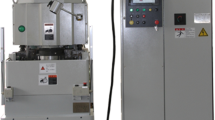Abstract
Efficient application of minimum quantity lubrication (MQL) in grinding is not only related to grinding conditions and delivery parameters but also affected by spraying atomization characteristics. In this study, a double-outlet nozzle is proposed and the flow field of the MQL grinding is investigated by two-stage atomization model. The side-mixing structure of double-outlet nozzle indicates that the grinding fluid is atomized at the windward side and the flow rate of grinding fluid for a single radial hole is smaller than that for the liquid pipe. Therefore, more excellent atomization performances, in terms of liquid droplet size, uniformity, and velocity of the liquid droplets, are obtained for double-outlet nozzle in comparison with single-outlet nozzle. The liquid droplets sprayed from auxiliary outlet of double-outlet nozzle impact on the grinding wheel and change the airflow direction around the grinding wheel. Thus, the air barrier around the grinding wheel is disturbed and the liquid droplets sprayed from main outlet can be injected into the grinding zone easily. Experimental results indicate that two-stage atomization model is reliable.
Similar content being viewed by others
References
Ding WF, Zhao B, Xu JH, Yang CY, Fu YC, Su HH (2014) Grinding behavior and surface appearance of (TiCp + TiBw)/Ti-6Al-4V titanium matrix composites. Chin J Aeronaut 27(5):1334–1342
Zhang XH, Yan C, Chen GY, An WK, Deng ZH (2014) Experimental investigations of microcracks in laser induced cracking turning alumina ceramic. Mater Manuf Process 29(10):1277–1283
Malkin S, Guo C (2008) Grinding technology: theory and application of machining with abrasives. Industrial Press, New York
Barczak LM, Batako ADL, Morgan MN (2010) A study of plane surface grinding under minimum quantity lubrication (MQL) condition. International Journal of Machine Tools & Manufacture 50:977–985
Morgan MN, Barczak L, Batako A (2012) Temperatures in fine grinding with minimum quantity lubrication (MQL). Int J Adv Manuf Technol 60:951–958
Hadad MJ, Tawakoli T, Sadeghi MH, Sadeghi B (2012) Temperature and energy partition in minimum quantity lubrication-MQL grinding process. International Journal of Machine Tools & Manufacture 54:10–17
Ebbrell S, Woolley NH, Tridimas YD, Allanson DR, Rowe WB (2000) The effects of cutting fluid application methods on the grinding process. International Journal of Machine Tools & Manufacture 40:209–223
Tawakoli T, Hadad MJ, Sadeghi MH (2010) Influence of oil mist parameters on minimum quantity lubrication-MQL grinding process. International Journal of Machine Tools & Manufacture 50:521–531
Zhang YB, Li CH, Jia DZ, Zhang DK, Zhang XW (2015) Experimental evaluation of MoS2 nanoparticles in jet MQL grinding with different types of vegetable oil as base oil. J Clean Prod 87:930–940
Mao C, Zou HF, Huang XM, Zhang J, Zhou ZX (2013) The influence of spraying parameters on grinding performance for nanofluid minimum quantity lubrication. Int J Adv Manuf Technol 64:1791–1799
Emami M, Sadeghi MH, Sarhan AAD (2013) Investigating the effects of liquid atomization and delivery parameters of minimum quantity lubrication on the grinding process of Al2O3 engineering ceramics. J Manuf Process 15:374–388
Park KH, Olortegui-Yume J, Yooh MC, Kwon P (2010) A study on droplets and their distribution for minimum quantity lubrication (MQL). Int J Adv Manuf Technol 50:824–833
Zuzio D, Estivalezes JL, Villedieu P, Blanchard G (2013) Numerical simulation of primary and secondary atomization. Comptes Rendus Mecanique 341:15–25
Tang YC, He N, Zhao W, Li L, Yang YF (2013) Simulation of two-stage atomization and experimental study on minimum quantity lubrication. Tool Engineering 47(1):3–6
Jiang X, Siamas GA, Jagus K, Karayiannis TG (2010) Physical modelling and advanced simulations of gas–liquid two-phase jet flows in atomization and sprays. Prog Energy Combust Sci 36:131–167
Li GB, Zeng ZY, Deng B (2011) An research on numerical simulation of an air blast atomizer. Ship Electronic Engineering 31(5):128–136
Sadeghi MH, Hadad MJ, Tawakoli T, Vesali A, Emami M (2010) An investigation on surface grinding of AISI 4140 hardened steel using minimum quantity lubrication-MQL technique. Int J Mater Form 3:241–251
Silva LR, Bianchi EC, Fusse RY, Catai RE, Franca TV, Aguiar PR (2007) Analysis of surface integrity for minimum quantity lubricant-MQL in grinding. International Journal of Machine Tools & Manufacture 47:412–418
Liu XL, Li L, Zhao W, He N, Shi Q (2011) Study on cutting oil mist spray characteristic based on minimum quantity lubrication. Tool Engineering 45(12):16–18
An AL, Fu YC, Xu JH, Xu HJ (2006) The cooling effects of cryogenic pneumatic mist jet impinging in grinding of titanium alloys. Key Eng Mater 305:575–578
Author information
Authors and Affiliations
Corresponding author
Rights and permissions
About this article
Cite this article
Mao, C., Zhou, X., Yin, L. et al. Investigation of the flow field for a double-outlet nozzle during minimum quantity lubrication grinding. Int J Adv Manuf Technol 85, 291–298 (2016). https://doi.org/10.1007/s00170-015-7896-2
Received:
Accepted:
Published:
Issue Date:
DOI: https://doi.org/10.1007/s00170-015-7896-2




